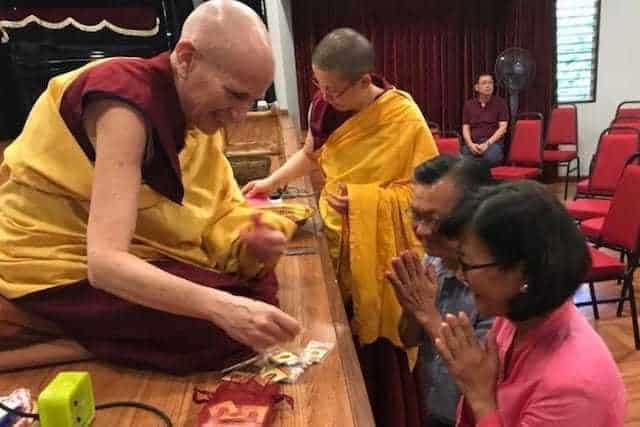Perfection of generosity
The text turns to training the mind on the stages of the path of advanced level practitioners. Part of a series of teachings on the Gomchen Lamrim by Gomchen Ngawang Drakpa. Visit Gomchen Lamrim Study Guide for a full list of contemplation points for the series.
- The result of practicing generosity in this life
- Having discernment about when to give
- Overcoming hesitation and antidotes to miserliness
- Giving material aid and protection from fear
- Many ways of giving the Dharma
Gomchen Lamrim 115: Perfection of Generosity (download)
Contemplation points
Venerable Jigme defined generosity as an attitude where we are willing to give whatever is needed by others. With that in mind, contemplate the following:
- Using examples from the teaching and from your own experience: What are some of the benefits of generosity just in this life? What are the benefits of generosity in future lives?
- Imagine the qualities of true generosity: giving without hesitation, without obstacle, having the discriminating wisdom to know what to give when. What would it be like to live these qualities. Spend time considering each. What can you do to begin cultivating these qualities now?
- Venerables Tsepal and Tarpa suggested that approaching the world with a heart of generosity directly opposes the complaining, critical mind. Consider how that process works. How you can overcome your own negativity, complaint, and criticism through the attitude of generosity?
- Consider your motivation when giving. Are you usually aware of it? Reflect on acts of generosity you have done in the past. What has motivated you (true generosity, obligation, pride, reputation)? What can you do to get more clean-clear about your motivation and transform it into the true wish to benefit?
- Consider the three types of generosity: giving material aid, freedom from fear, and giving the Dharma. Give examples of each (big and small) that you have witnessed in your own life and in the world. Looking at each type of generosity, in what situations do you find giving quite natural? Rejoice!
- Again, looking at each type of generosity, in what situations do you find you struggle in being generous? What arises in your own mind that prevents you from giving in any of the three ways? What can you do, what antidotes can you apply, to begin to overcome these obstacles? Consider specific things you can do for each of these three types of giving to help build the habit of generosity (smiling at a stranger, holding the door for someone, not lashing out in anger, encouraging a friend, taking the time to visit with an elderly neighbor, etc).
- Go through how to practice generosity coupled with each of the other far-reaching practices: the ethics of generosity, the fortitude of generosity, the joyous effort of generosity, the meditative stability of generosity, the wisdom of generosity. How might thinking in this way influence the power of your generosity and the way you interact with others?
- Remembering that cultivating generosity happens both on and off the cushion, resolve to cultivate this attitude in your meditation time, transform your motivations, and be mindful of interacting with others in your daily life with an increasingly generous heart.
Venerable Thubten Jigme
Venerable Jigme met Venerable Chodron in 1998 at Cloud Mountain Retreat Center. She took refuge in 1999 and attended Dharma Friendship Foundation in Seattle. She moved to the Abbey in 2008 and took sramanerika and sikasamana vows with Venerable Chodron as her preceptor in March 2009. She received bhikshuni ordination at Fo Guang Shan in Taiwan in 2011. Before moving to Sravasti Abbey, Venerable Jigme (then Dianne Pratt) worked as a Psychiatric Nurse Practitioner in private practice in Seattle. In her career as a nurse, she worked in hospitals, clinics and educational settings. At the Abbey, Ven. Jigme is the Guest Master, manages the prison outreach program and oversees the video program.


